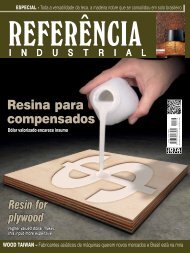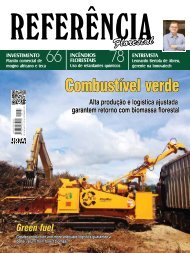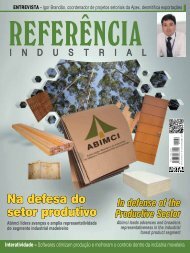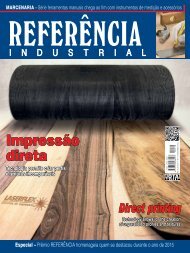Setembro/2016 - Referência Industrial 178
Visitantes - Grupo Jota Comunicação
Visitantes - Grupo Jota Comunicação
Create successful ePaper yourself
Turn your PDF publications into a flip-book with our unique Google optimized e-Paper software.
diretamente associado às indústrias, gerando empregos na<br />
maioria dos casos para os formados. “Vemos que a marcenaria<br />
está ganhando alguns rumos. Se for considerar a redução de<br />
preço, o investimento futuro será em coladeiras de borda e<br />
furadeiras múltiplas. Agora, se for pensar em móvel com alto<br />
valor agregado, em que você vai ter peças exclusivas, aí nós<br />
voltamos para esquadrejadeiras e ferramentas manuais.”<br />
Um dos polos moveleiros mais importantes do país, o<br />
município de Ubá tem, na maioria, marceneiros formados<br />
pelo Senai (MG). Responsável pelo curso na cidade, Rafael<br />
Mantovani Cardoso conta que o curso marceneiro é adaptado<br />
à realidade industrial da cidade, que é o trabalho com chapas.<br />
“Há um relacionamento estreito com o Intersind (Sindicato<br />
Intermunicipal das Indústrias do Mobiliário de Ubá) e também<br />
diretamente com as indústrias, onde buscamos sempre direcionar<br />
nossas práticas à realidade das industrias do nosso polo<br />
moveleiro”, conta ele, que afirma que o mercado busca cada<br />
vez mais profissionais capacitados, devido à alta na busca por<br />
móveis rústicos. “Os produtos deste tipo são mais originais,<br />
pois utilizam madeira maciça em sua maioria, dependendo<br />
de profissionais especializados na marcenaria tradicional.”<br />
Em Ubá, são oferecidos cinco tipos de cursos para profissionalizar<br />
o setor: aprendizagem em marceneiro, qualificação<br />
em marceneiro e montador de móveis, técnico em móveis e<br />
design de móveis. “A grande tendência que observamos aqui,<br />
nos últimos anos, é a automatização. A indústria tem utilizado<br />
em seu parque industrial seccionadoras convencionais e<br />
CNC, esquadra bordas, filetadeiras, lixadeiras banda larga<br />
e de perfil e furadores convencionais, entre outros”, conta<br />
Rafael. “Além do polo ter um histórico de trabalho empírico,<br />
os cursos técnicos daqui têm trazido um olhar diferenciado,<br />
fazendo com que a área tenha resultados mais assertivos e<br />
de acordo com a tendência do mercado.”<br />
ting jobs in most cases for the graduates. “We see that woodworking<br />
is expanding as a work area. If you are considering<br />
price reduction, future investments will be in edge gluers and<br />
multiple drills. Now, if you're thinking about high added value<br />
furniture, where there are one-off pieces, then we go back to<br />
the sliding table saw and hand tools.”<br />
In one of the Country's most important furniture manufacturing<br />
centers, the Municipality of Ubá, most furniture<br />
makers are trained by Senai-MG. Rafael Mantovani Cardoso,<br />
responsible for the course in the Municipality, says that the<br />
woodworking course is adapted to the Municipality’s industrial<br />
reality, which is working with panels. “There is a close<br />
relationship with the Ubá Intermunicipal Class Association<br />
of Furniture Manufacturers (Intersind) and also directly with<br />
companies, where we always seek to direct our practices to<br />
the reality of our furniture manuacturers,” says Rafael Mantovani,<br />
who claims that the market is increasingly looking for<br />
qualified professionals, due to the higher demand for rustic<br />
furniture. “This type of product is more original, because it is<br />
manufactured from solid wood for the most part, and depends<br />
on traditional specialized furniture making professionals.”<br />
In Ubá, five types of courses are offered to professionalize<br />
in the sector: learning woodworking, furniture making and furniture<br />
assembly qualification, technician in furniture making,<br />
and furniture design. “In recent years, the major trend that<br />
we observe here is to automation. The industry used to use<br />
conventional tools such as overhead panel saws and CNC’s,<br />
edgers, hand files, broadband and profile sanders, and drilling<br />
machines, amongst others, in their industrial parks,” says<br />
Rafael. “In addition the manufacturing center has a history<br />
of empirical work, the technical courses here have created a<br />
distinctive look, so that the area has more assertive results<br />
and in accord with market trends.”<br />
MARCENARIA COMO HOBBY<br />
Não só a indústria tem buscado mudanças nos cursos<br />
ofertados aos marceneiros, mas os próprios consumidores se<br />
tornaram uma parcela significativa dos aprendizes no ofício. A<br />
Confraria da Madeira, surgida em Porto Alegre (RS) em 2012, é<br />
a primeira escola da cidade a oferecer o curso como um hobby.<br />
“Apesar do foco no DIY (do it yourself), nossos participantes<br />
não perdem conhecimento quando comparado a cursos tradicionais”,<br />
conta André Campos, diretor da Confraria. “Além<br />
de focar em um mercado que tende a crescer muito nos próximos<br />
anos, inovamos no formato. Vemos as marcenarias e<br />
indústrias como complemento e não competição às nossas<br />
ofertas. Aqui as pessoas desenvolvem projetos básicos e de<br />
baixa complexidade, enquanto que trabalhos mais elaborados<br />
serão executados pelas grandes fábricas dos polos nacionais.”<br />
WOODWORKING AS A HOBBY<br />
Not only has the industry sought changes in the courses<br />
offered to woodworkers, but consumers themselves have<br />
become a significant portion of apprentices of the craft. The<br />
Confraria da Madeira (Brotherhood of Wood), which arose in<br />
Porto Alegre (RS) in 2012, is the first school in the district to<br />
offer courses as a hobby. “Despite the focus on ‘do it yourself’<br />
(DIY), our participants do not lose out on knowledge gained<br />
when compared to traditional courses,” says André Campos,<br />
Director of the Confraria. “In addition to focusing on a market<br />
that tends to grow in the years ahead, we have innovated in<br />
format. We see the furniture makers and manufacturers as<br />
a complement and not competition to what we offer. Here<br />
people learn how to carry out basic and low complexity designs,<br />
while more elaborate designs are carried out by large<br />
manufacturers in the domestic producer centers.”<br />
SETEMBRO | 39

















